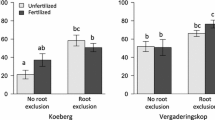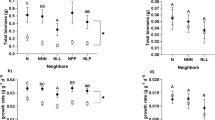Abstract
The competitive superiority of invasive plants plays a key role in the process of plant invasions, enabling invasive plants to overcome the resistance of local plant communities. Fast aboveground growth and high densities lead to the competitive superiority of invasive species in the competition for light. However, little is understood of the role belowground root competition may play in invasion. We conducted an experiment to test the effect of root growth on the performance of an invasive shrub Cassia alata, a naturalized, non-invasive shrub Corchorus capsularis, and a native shrub Desmodium reticulatum. We compared seedling growth of the three species and their competitive ability in situ. The roots of the C. alata seedlings grew much faster than those of C. capsularis and D. reticulatum during the entire growth period although C. alata had shorter shoots than D. reticulatum. Furthermore, C. alata showed an apparent competition advantage compared to the other two species as evidenced by less biomass reduction in intraspecific competition and higher competitive effects in interspecific competition. Our study reveals that fast seedling root growth may be important in explaining the competitive advantages of invasive plants. Future studies should pay more attention to the belowground traits of invasive plants, the trade-off between shoot and root growth, and the role of root competition in affecting the population dynamics of invasive plants and the structures of invaded communities.





Similar content being viewed by others
References
Amsberry L, Baker MA, Ewanchuk PJ, Bertness MD (2000) Clonal integration and the expansion of Phragmites australis. Ecol Appl 10(4):1110
Baker HG (1964) Characteristics and modes of origin of weeds. Academic Press, New York
Bardgett RD, Mommer L, De Vries FT (2014) Going underground: root traits as drivers of ecosystem processes. Trends Ecol Evol 29(12):692–699
Belcher JW, Keddy PA, Twolan-Strutt L (1995) Root and shoot competition intensity along a soil depth gradient. J Ecol 83(4):673–682
Burke MJW, Grime JP (1996) An experimental study of plant community invasibility. Ecology 77(3):776–790
Cadotte MW, Murray BR, Lovett-Doust J (2006) Ecological patterns and biological invasions: using regional species inventories in macroecology. Biol Invasions 8(4):809–821
Chen W, Zeng H, Eissenstat DM, Guo D (2013) Variation of first-order root traits across climatic gradients and evolutionary trends in geological time. Glob Ecol Biogeogr 22(7):846–856
Clark RT, MacCurdy RB, Jung JK, Shaff JE, McCouch SR, Aneshansley DJ, Kochian LV (2011) Three-dimensional root phenotyping with a novel imaging and software platform. Plant Physiol 156(2):455–465
Comas LH, Eissenstat DM (2009) Patterns in root trait variation among 25 co-existing North American forest species. New Phytol 182(4):919–928
Coomes DA, Grubb PJ (1998) Responses of juvenile trees to above- and belowground competition in nutrient-starved Amazonian rain forest. Ecology 79(3):768
Coomes DA, Grubb PJ (2000) Impacts of root competition in forests and woodlands: a theoretical framework and review of experiments. Ecol Monogr 70(2):171–207
Craine JM, Dybzinski R (2013) Mechanisms of plant competition for nutrients, water and light. Funct Ecol 27(4):833–840
Craine JM, Fargione J, Sugita S (2005) Supply pre-emption, not concentration reduction, is the mechanism of competition for nutrients. New Phytol 166(3):933–940
Davis MA, Grime JP, Thompson K (2000) Fluctuating resources in plant communities: a general theory of invasibility. J Ecol 88(3):528–534
Dehlin H, Peltzer DA, Allison VJ, Yeates GW, Nilsson MC, Wardle DA (2008) Tree seedling performance and below-ground properties in stands of invasive and native tree species. N Z J Ecol 32(1):67–79
Dunbabin VM, Postma JA, Schnepf A et al (2013) Modelling root–soil interactions using three-dimensional models of root growth, architecture and function. Plant Soil 372(1–2):93–124
Fang S, Yan X, Liao H (2009) 3D reconstruction and dynamic modeling of root architecture in situ and its application to crop phosphorus research. Plant J 60(6):1096–1108
Fitter A (1987) An architectural approach to the comparative ecology of plant root systems. New Phytol 106(s1):61–77
Flora of China Editorial Committee (1994) Flora of China. Science Press, Beijing
Freschet GT, Cornelissen JHC, van Logtestijn RSP, Aerts R (2010) Evidence of the “plant economics spectrum” in a subarctic flora. J Ecol 98(2):362–373
Funk JL, Wolf AA (2016) Testing the trait-based community framework: do functional traits predict competitive outcomes? Ecology 97(9):2206–2211
Gersani M, O’Brien EE, Maina GM, Abramsky Z (2001) Tragedy of the commons as a result of root competition. J Ecol 89(4):660–669
Gioria M, Osborne BA (2014) Resource competition in plant invasions: emerging patterns and research needs. Front Plant Sci 5:501
Goldberg DE (1990) Components of resource competition in plant communities. In: Grace JB, Tilman D (eds) Perspectives on plant competition. Academic Press, San Diego, pp 27–49
Grotkopp E, Rejmánek M (2007) High seedling relative growth rate and specific leaf area are traits of invasive species: phylogenetically independent contrasts of woody angiosperms. Am J Bot 94(4):526–532
Grotkopp E, Rejmánek M, Rost TL (2002) Toward a causal explanation of plant invasiveness: seedling growth and life-history strategies of 29 pine (Pinus) species. Am Nat 159(4):396–419
Hodge A, Berta G, Doussan C, Merchan F, Crespi M (2009) Plant root growth, architecture and function. Plant Soil 321(1–2):153–187
Iponga DM, Milton SJ, Richardson DM (2008) Superiority in competition for light: a crucial attribute defining the impact of the invasive alien tree Schinus molle (Anacardiaceae) in South African savanna. J Arid Environ 72(5):612–623
Keddy PA, Shipley B (1989) Competitive hierarchies in herbaceous plant communities. Oikos 54(2):234–241
Kiær LP, Weisbach AN, Weiner J (2013) Root and shoot competition: a meta-analysis. J Ecol 101(5):1298–1312
Klein T, Siegwolf RTW, Körner C (2016) Belowground carbon trade among tall trees in a temperate forest. Science 352(6283):342–344
Kong D, Ma C, Zhang Q, Li L, Chen X, Zeng H, Guo D (2014) Leading dimensions in absorptive root trait variation across 96 subtropical forest species. New Phytol 203(3):863–872
Kraft NJ, Godoy O, Levine JM (2015) Plant functional traits and the multidimensional nature of species coexistence. Proc Natl Acad Sci 112(3):797–802
Kramer-Walter KR, Bellingham PJ, Millar TR, Smissen RD, Richardson SJ, Laughlin DC, Mommer L (2016) Root traits are multidimensional: specific root length is independent from root tissue density and the plant economic spectrum. J Ecol 104(5):1299–1310
Kueffer C, Schumacher E, Fleischmann K, Edwards PJ, Dietz H (2007) Strong below-ground competition shapes tree regeneration in invasive Cinnamo mumverum forests. J Ecol 95:273–282
Kunstler G, Falster D, Coomes DA et al (2016) Plant functional traits have globally consistent effects on competition. Nature 529(7585):204–207
Leishman MR, Haslehurst T, Ares A, Baruch Z (2007) Leaf trait relationships of native and invasive plants: community- and global-scale comparisons. New Phytol 176(3):635–643
Levine JM (2008) Biological invasions. Curr Biol 18(2):R57–R60
Levine JM, Adler PB, Yelenik SG (2004) A meta-analysis of biotic resistance to exotic plant invasions. Ecol Lett 7(10):975–989
Li H, Xia H, Fu S, Zhang X (2009) Emission of soil greenhouse gases in response to understory removal and Cassia alata addition in an Eucalytus urophylla plantaton in Guangdong Province, China. Chin J Plant Ecol 33(6):1015–1022
Liu Y, van Kleunen M (2017) Responses of common and rare aliens and natives to nutrient availability and fluctuations. J Ecol 105(4):1111–1122
Liu G, Freschet GT, Pan X, Cornelissen JHC, Li Y, Dong M (2010) Coordinated variation in leaf and root traits across multiple spatial scales in Chinese semiarid and arid ecosystems. New Phytol 188(2):543–553
Luo X, Zhou X, Yan X (2004) Visualization of plant root morphology in situ based on X-ray CT imaging technology. In: 2004 ASAE annual meeting. American Society of Agricultural and Biological Engineers, p 1
Mack RN, Simberloff D, Lonsdale WM, Evans H, Clout M, Bazzaz FA (2000) Biotic invasions: causes, epidemiology, global consequences, and control. Ecol Appl 10(3):689–710
Maeght JL, Rewald B, Pierret A (2013) How to study deep roots—and why it matters. Front Plant Sci 4:299
McCormack LM, Adams TS, Smithwick EAH, Eissenstat DM (2012) Predicting fine root lifespan from plant functional traits in temperate trees. New Phytol 195(4):823–831
Mommer L, van Ruijven J, Jansen C, van de Steeg HM, de Kroon H (2012) Interactive effects of nutrient heterogeneity and competition: implications for root foraging theory? Funct Ecol 26(1):66–73
Morris LL, Walck JL, Hidayati SN (2002) Growth and reproduction of the invasive Ligustrum sinense and native Forestiera ligustrina (Oleaceae): implications for the invasion and persistence of a nonnative shrub. Int J Plant Sci 163(6):1001–1010
Ordonez A, Olff H (2013) Do alien plant species profit more from high resource supply than natives? A trait-based analysis. Glob Ecol Biogeogr 22(6):648–658
Rajaniemi TK, Allison VJ, Goldberg DE (2003) Root competition can cause a decline in diversity with increased productivity. J Ecol 91(3):407–416
Reich BR (2014) The world-wide “fast–slow” plant economics spectrum: a traits manifesto. J Ecol 102(2):275–301
Savage K, Davidson EA, Tang J (2013) Diel patterns of autotrophic and heterotrophic respiration among phenological stages. Glob Change Biol 19(4):1151–1159
Schenk HJ (2006) Root competition: beyond resource depletion. J Ecol 94(4):725–739
Schwinning S, Weiner J (1998) Mechanisms determining the degree of size asymmetry in competition among plants. Oecologia 113(4):447–455
Silvertown J, Charlesworth D (2009) Introduction to plant population biology. Wiley, Oxford
Simberloff D, Martin JL, Genovesi P et al (2013) Impacts of biological invasions: what’s what and the way forward. Trends Ecol Evol 28(1):58–66
Trinder CJ, Brooker RW, Robinson D (2013) Plant ecology’s guilty little secret: understanding the dynamics of plant competition. Funct Ecol 27(4):918–929
Valverde-Barrantes OJ, Freschet GT, Roumet C, Blackwood CB (2017) A worldview of root traits: the influence of ancestry, growth form, climate and mycorrhizal association on the functional trait variation of fine-root tissues in seed plants. New Phytol 215(4):1562–1573
van Kleunen M, Weber E, Fischer M (2010) A meta-analysis of trait differences between invasive and non-invasive plant species. Ecol Lett 13(2):235–245
van Kleunen M, Dawson W, Essl F et al (2015) Global exchange and accumulation of non-native plants. Nature 525(7567):100–103
Vilà M, Weiner J (2004) Are invasive plant species better competitors than native plant species? Evidence from pair-wise experiments. Oikos 105(2):229–238
Vilà M, Gómez A, Maron JL (2003) Are alien plants more competitive than their native conspecifics? A test using Hypericum perforatum L. Oecologia 137(2):211–215
Violle C, Garnier E, Lecoeur J, Roumet C, Podeur C, Blanchard A, Navas ML (2009) Competition, traits and resource depletion in plant communities. Oecologia 160(4):747–755
Wang P, Stieglitz T, Zhou DW, Cahill JF (2010) Are competitive effect and response two sides of the same coin, or fundamentally different? Funct Ecol 24(1):196–207
Weemstra M, Mommer L, Visser EJW, Van Ruijven J, Kuyper TW, Mohren GMJ, Sterck FJ (2016) Towards a multidimensional root trait framework: a tree root review. New Phytol 211(4):1159–1169
Weiner J (1990) Asymmetric competition in plant populations. Trends Ecol Evol 5(11):360–364
Weiner J (2004) Allocation, plasticity and allometry in plants. Perspect Plant Ecol Evol Syst 6(4):207–215
Wilson JB (1988) Shoot competition and root competition. J Appl Ecol 25(1):279–296
Xu H, Qiang S (2011) China’s invasive aline species. Science Press, Beijing
Yang J (2011) The status and management countermeasures of alien biological invasion in China. Dissertation, Yangtze University, Jingzhou
Acknowledgements
We thank Prof. Fangliang He from University of Alberta for comments on the manuscript. This work was funded by the National Natural Science Foundation of China Grant (No. 31370441) and Pearl River S&T Nova Program of Guangzhou (201610010082).
Author information
Authors and Affiliations
Contributions
MN and SF conceived the project and designed the experiments. NM conducted the experiments and analyses. MN, YL, CC, HX and SF wrote the manuscript. All authors contributed critically to the drafts and gave final approval for publication.
Corresponding author
Electronic supplementary material
Below is the link to the electronic supplementary material.
Rights and permissions
About this article
Cite this article
Ni, M., Liu, Y., Chu, C. et al. Fast seedling root growth leads to competitive superiority of invasive plants. Biol Invasions 20, 1821–1832 (2018). https://doi.org/10.1007/s10530-018-1664-9
Received:
Accepted:
Published:
Issue Date:
DOI: https://doi.org/10.1007/s10530-018-1664-9




